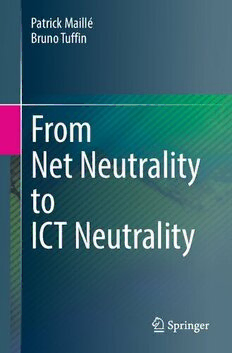
From Net Neutrality to ICT Neutrality PDF
Preview From Net Neutrality to ICT Neutrality
Patrick Maillé Bruno Tuffin From Net Neutrality to ICT Neutrality From Net Neutrality to ICT Neutrality Patrick Maillé (cid:129) Bruno Tuffin From Net Neutrality to ICT Neutrality PatrickMaillé BrunoTuffin IMTAtlantique CentreInriadel’UniversitédeRennes Rennes,France Rennes,France ISBN978-3-031-06270-4 ISBN978-3-031-06271-1 (eBook) https://doi.org/10.1007/978-3-031-06271-1 ©TheEditor(s)(ifapplicable)andTheAuthor(s),underexclusivelicensetoSpringerNatureSwitzerland AG2022 Thisworkissubjecttocopyright.AllrightsaresolelyandexclusivelylicensedbythePublisher,whether thewhole orpart ofthematerial isconcerned, specifically therights oftranslation, reprinting, reuse ofillustrations, recitation, broadcasting, reproductiononmicrofilmsorinanyotherphysicalway,and transmissionorinformationstorageandretrieval,electronicadaptation,computersoftware,orbysimilar ordissimilarmethodologynowknownorhereafterdeveloped. Theuseofgeneraldescriptivenames,registerednames,trademarks,servicemarks,etc.inthispublication doesnotimply,evenintheabsenceofaspecificstatement,thatsuchnamesareexemptfromtherelevant protectivelawsandregulationsandthereforefreeforgeneraluse. Thepublisher,theauthorsandtheeditorsaresafetoassumethattheadviceandinformationinthisbook arebelievedtobetrueandaccurateatthedateofpublication.Neitherthepublishernortheauthorsor theeditorsgiveawarranty,expressedorimplied,withrespecttothematerialcontainedhereinorforany errorsoromissionsthatmayhavebeenmade.Thepublisherremainsneutralwithregardtojurisdictional claimsinpublishedmapsandinstitutionalaffiliations. ThisSpringerimprintispublishedbytheregisteredcompanySpringerNatureSwitzerlandAG Theregisteredcompanyaddressis:Gewerbestrasse11,6330Cham,Switzerland Preface ICT (for Information and Communication Technology) is omnipresent in our modern society, and the economy has gone beyond the industrial economy to the Internet and ICT economy. Thanks to hyper-connectivity, there are now lots of opportunitiesforinnovation.AsofJanuary2022,thetop3mostvaluablecompanies worldwideareallICTcompanies(AppleInc.,Microsoft,AlphabetInc.),andthree other ICT companies (Amazon Inc., Facebook, Tencent) appear in the top 10.1 Internet Service Providers (ISPs), Content Delivery Networks (CDNs) and cloud providers,andsocialnetworkactors,allservicesandcontentprovidersare among actorsresearchingabusinessmodelasprofitableaspossible. ButthesuccessofICTisoftencoinedtobelinkedtotheopenandfreeInternet, fosteringparticipationandinnovation.Withnumerousactorswillingtodesignand implement business models to increase their revenue, the impact on the whole network outcome can be significant. That issue has been highlighted when ISPs startedclaimingthatsomebigcontentproviders,representinganimportantpartof the traffic flowing throughtheir network,shouldparticipate to the networkinfras- tructureupgradingcosts,withthethreatofbeingblockedorsloweddownincaseof refusal.Thislaunchedthenetworkneutralitydebate.Basically,netneutralitymeans thatInternetprovidersshouldtreatallInternetpacketsthesameway,regardlessof their type, content, origin, or destination. Network (non-)neutrality has become a very hot topic in the past few years, at the same time from political, economic, anddailylifepointsofview,becauseitmayrefashiontheInternetbusinessmodel andingeneralthetelecommunicationsvisionandfuture.Ourpurposeistoreview thedebateanddiscussargumentsandregulationpassedworldwide.Wealsoaimat providingabalancebetweenmathematicaltheoryandpracticaldiscussion. Anotherissue is thatwhile thenetworkneutralityissue hasbeenthepolarizing onISPs’role,theInternethaschangedfromthesimplecontent-ISP-usersdelivery chain to a more complicated ecosystem with numerous intermediaries between content and users and players affecting the online experience. The book aims at 1https://fxssi.com/top-10-most-valuable-companies-in-the-world. v vi Preface highlighting the role of those other actors (CDNs, search engines, “structuring platforms,” social networks, etc.) and the impact of their possibly non-neutral behavior,which can bypass the general neutrality principles without violating the (packet-based)rulescurrentlyevokedinthedebate.Atypicalexampleistheranking algorithms of search engines being suspected of voluntarily putting in a higher position their own businesses or their “relations” and lowering the position of competitors, leading to the so-called search neutrality debate. One of our goals is open the reader to the complications of limiting the neutrality debate to ISPs, potentially requiring to extend the neutrality framework to a general definition encompassing all actors and clarifying the rules. That issue leads to a debate on the transparencyof algorithms, expected by regulatorybodies, that we hint in the lastchapters. We hope that the text will open the readers’ mind to the issues of fairness, freedom, and economic efficiency, among others, and illustrate the complexity of confronting those high-level considerations with the constantly evolving ICT technicalrealities. Rennes,France PatrickMaillé BrunoTuffin Acknowledgments We, the authors, would like to thank the editors, in particular Ralf Gerstner, for their assistance, encouragement,and patience duringthe preparationof this book. Any mistake, error of judgement, or treatment imbalance in the book is our sole responsibility. vii Contents 1 Introduction:ABitofHistory ............................................ 1 1.1 The Adventof the Digital Economyand the Need forRegulation.......................................................... 1 1.2 TheInternet:WorriesAbouttheLackofNeutrality................. 4 1.3 NewServices:NewDifficultiesandPotentialHindrance toSociety............................................................... 7 1.4 TowardICTNeutrality?............................................... 12 1.5 GoalandOrganizationofThisBook ................................. 12 2 Definitions................................................................... 15 2.1 SeveralDefinitionsofNeutrality...................................... 16 2.2 AnalysisandComparison............................................. 19 2.3 SpecializedServices................................................... 21 2.3.1 PerimeterofSpecializedServices............................ 22 2.3.2 NeedforSpecializedServices................................ 23 2.3.3 ImplicationsofIntroducingaSpecialClassofService...... 23 2.4 Zero-RatingandSponsoredData ..................................... 24 2.5 PublicConsultations................................................... 26 2.6 WorldwideImplementations.......................................... 27 2.6.1 NorthAmerica................................................. 27 2.6.2 Europe ......................................................... 29 2.6.3 Asia ............................................................ 32 2.6.4 Oceania ........................................................ 34 2.6.5 SouthAmerica................................................. 34 2.6.6 Africa .......................................................... 35 2.7 ASituationStillEvolving............................................. 35 2.8 ATrade-OffwithUsersDecidingDifferentiation?.................. 37 2.9 Conclusions............................................................ 38 ix x Contents 3 ProsandCons:TheArgumentsintheDebate .......................... 39 3.1 The“Freedom”Arguments:WhoseFreedom?....................... 40 3.1.1 [Pro-NN]NetNeutralityIsNeededtoGuarantee FreeSpeech.................................................... 40 3.1.2 [Anti-NN]NetNeutralityHindersOperators’ FreedomofEnterprise......................................... 41 3.2 The“Investment”Arguments......................................... 41 3.2.1 [Anti-NN]ReturnsonInvestmentsAreNeeded............. 41 3.2.2 [Pro-NN]MoreCustomers,MoreInvestments .............. 42 3.3 The“CompetitionandInnovation”Arguments...................... 42 3.3.1 [Pro-NN]Non-neutralityBiasestheCompetition AmongServices............................................... 42 3.3.2 [Anti-NN]ISPsFavoringSomeContentProviders StimulatesISPCompetition(ThroughContent)............. 43 3.3.3 [Pro-NN]NeutralityIsNeededtoAllowInnovating Newcomers .................................................... 44 3.4 The“SecurityandPrivacy”Arguments .............................. 44 3.4.1 [Anti-NN]EncryptionAlreadyPreventsDiscrimination.... 44 3.4.2 [Pro-NN]NeutralityHelpsProtectPrivacy .................. 44 3.5 The“Welfare”Arguments............................................. 45 3.5.1 [Pro-NN] Non-neutralityWould Lead to a FragmentedInternet,WhichIsBadForUsers............... 45 3.5.2 [Anti-NN]ContentProvidersShouldContribute totheInfrastructureCoststoReduceUsers’Share.......... 45 3.5.3 [Anti-NN]AFreeMarketFindstheMostEfficient Outcome ....................................................... 46 3.6 Conclusions............................................................ 46 4 MathematicalAnalysis .................................................... 47 4.1 IntroductiontoMathematicalModelingandGameTheory......... 48 4.1.1 ElementsofNon-cooperativeGameTheory................. 48 4.1.2 OutputAnalysis ............................................... 50 4.1.3 PrincipleofMechanismDesign .............................. 52 4.2 ABasicModel......................................................... 53 4.3 ModelwithTwoContentProviders................................... 60 4.3.1 PricingGameBetweenCPs(α =2) ......................... 63 4.3.2 FullyNeutralCase(α =2) ................................... 64 4.3.3 WeaklyNeutralCase(α =2)................................. 64 4.3.4 Non-neutralCase(α =2)..................................... 65 4.3.5 Comparison.................................................... 65 4.4 OtherConclusionsfromtheLiterature ............................... 66 4.5 AdditionalNotes....................................................... 68 Contents xi 5 Non-neutralityPushedbyContentProviders........................... 69 5.1 Non-neutralityasaBarriertoEntryProtectingIncumbents......... 70 5.1.1 ModelingtheImpactofaNewEntrantCP .................. 71 5.1.2 Actors’RevenuesandDecisionTimeScales ................ 73 5.1.3 AnalyzingtheGameforFixedSidePayments............... 74 5.1.4 CantheISPandtheIncumbentCPAgreeonSide Payments? ..................................................... 76 5.1.5 RefiningtheModel............................................ 79 5.2 SponsoredDataandZeroRating ..................................... 80 5.2.1 Modeling Sponsored-Data Practices in a CompetitiveISPContext...................................... 81 5.2.2 HowDoestheCPDecidetoSponsorandAdd Advertisement?................................................ 84 5.2.3 APracticeFinallyMostlyBenefitingISPs? ................. 85 5.3 WhenBigCPsDesignatethe“Good”ISPs:Incentivizing Non-neutralityWithoutPaying ....................................... 87 5.3.1 ISPCompetition:TheImportanceofLookingGood........ 87 5.3.2 ATwo-ISP,Two-CPmodelwithHeterogeneousUsers ..... 89 5.3.3 UserEquilibria:HowISPDecisionsAffectUser SubscriptionChoices.......................................... 91 5.3.4 TheGameAmongISPsandItsConsequences .............. 94 5.3.5 AModelYieldingUnexpectedConclusions................. 96 5.4 Conclusions............................................................ 97 6 AMoreGeneralViewofNeutrality...................................... 99 6.1 IsItRelevanttoGeneralizeNetworkNeutrality?.................... 99 6.2 ContentDeliveryNetworks:IntermediariesFlyingUnder theRadar?.............................................................. 101 6.2.1 IntroductiontoCDNRoleandImpact ....................... 101 6.2.2 Model Illustrating the Impact of CDNs on CompetitionBetweenCPs.................................... 103 6.2.3 Model Illustrating the Impact of CDNs on CompetitionBetweenISPs ................................... 110 6.3 IssuesRelatedtoVerticalIntegration................................. 112 6.3.1 VerticalIntegrationandtheInternetEcosystem ............. 112 6.3.2 IllustrationofVerticalIntegrationonOurBasicModel..... 114 6.3.3 OtherIllustrationsandResultsfromModels................. 117 6.4 DeviceNeutrality...................................................... 118 6.5 NeutralityofStructuringPlatforms................................... 119 6.6 AlsoTowardDataNeutrality? ........................................ 120 7 SearchNeutrality........................................................... 121 7.1 IsItinSearchEngines’InteresttoBeNeutral?...................... 122 7.1.1 ModelingtheLong-Termvs.Short-TermGains Trade-Off ...................................................... 124
